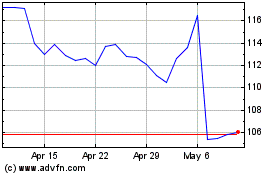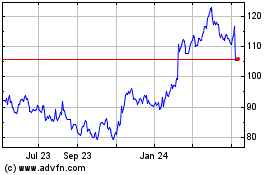By James T. Areddy
SHANGHAI -- Chinese law enforcement often relies on in-your-face
muscle-flexing, but Shanghai appears to be giving unusual leeway to
Walt Disney Co. to police its new theme park there nearly as
inconspicuously as in other Magic Kingdoms.
Shanghai Disneyland Resort promises to offer a study in the
cultural blend of U.S.-branded entertainment and Chinese
sensibilities -- Disney's dog Pluto outfitted as a character in the
Chinese zodiac, for instance. But a key question as Disney tweaks
its magic for the Middle Kingdom is how divergent philosophies on
crowd control get applied in a park that 330 million can reach in
less than three hours.
Disneyland officially won't open until June 16 but outsize
crowds already are flocking by cars and subway to new restaurants
and a lakeside promenade in a tourist zone surrounding the theme
park that offers a free taste of the experience -- 90,000 on one
recent day.
Shanghai events have drawn some of the largest crowds in the
world, and despite massive numbers of officers and widespread
electronic surveillance local authorities have a mixed response
record.
In 2010, Shanghai took a page from the heavily policed Beijing
Olympics two years earlier and stationed a battalion of officers,
paramilitary and army at the city's giant World's Fair expo, which
drew nearly half a million visitors daily for six months with
minimal incidents. But a year and a half ago, three dozen people
died in a New Year's Eve stampede after police failed to divert an
estimated 200,000 revelers from crushing into the city's No. 1
tourist spot, the historic riverfront Bund.
The Burbank, Calif.-based company's agreement gives it broad
scope to manage risks in Shanghai much like it does at Walt Disney
World Resort in Florida and its parks in other countries. Disney
won't say much about the arrangements but its plans indicate that
uniformed police generally won't be seen inside the park gates.
With three parks outside the U.S. in Hong Kong, Paris and Tokyo,
Disney faces localized risks, from earthquakes to terrorism.
Violent crime remains rare in China, and the primary concern for
Shanghai Disneyland -- reflected in the park's design -- is
preventing crowds from getting unwieldy.
A Disney spokesman said the resort's management company is
responsible for security inside the park. Shanghai's government
echoed that, adding that security would be supervised by a
"comprehensive law enforcement team." The area's top policeman, Li
Guirong, sidestepped a question about jurisdiction at a recent
press conference, saying only, "The standard for our
public-security management is very high."
In Shanghai, some of Disney's "security cast members" -- as the
company refers to guards -- wear yellow ties, white police style
hats and cartoonish badges emblazoned with a castle logo.
"Protecting the magic is the main goal," according to the job
description for security cast members on one Disney website in the
U.S., which shows guards dressed casually in leisurewear such as
straw hats and golf shirts.
A black Shanghai police surveillance van regularly parked near
Shanghai Disneyland's front gate is a reminder that ultimately
Chinese law enforcement hasn't been outranked by Disney
security.
In all, the purpose-built tourist zone including Shanghai
Disneyland covers an area about twice the size of New York's
Central Park. Near the theme park, local authorities operate a new
multibay firehouse and a large police compound. Paramilitary police
may appear in the area, though so far uniformed officers have been
seen mostly on traffic duty and sniffer-dog patrols.
Wang Hongwei, a professor of national security at Beijing's
Renmin University, says there is likely to be strong coordination.
He called the park "an important target for the government to keep
an eye on from a public security perspective."
Disney spent years working to make Chinese authorities
comfortable about its apolitical entertainment and security
competence. It toured Chinese police officials through each of its
five parks -- which draw more than 120 million annually -- to
demonstrate how it manages attendance.
Martin Lewison, a theme park expert at Farmingdale State College
in New York, predicts crowd management will feature "measures that
the Chinese middle class will find appropriate" because security
around Disneylands usually has local characteristics, such as
police on horseback outside the Paris park.
China's unapologetic policing isn't Disney's style. It famously
strives for subtle security like hidden cameras that won't distract
from the fun. Where Shanghai has X-ray machines in every one of its
subway stations, Disney theme parks only added them in the past
year or so.
In Shanghai, crowd control starts with regulating expectations.
Ticketing is handled through online reservations for specific days.
Controls weren't so tight in 2005. At Hong Kong Disneyland, a
sold-out day around China's National Day holiday prompted chaos,
with angry visitors who couldn't get in lifting their children over
the fence into the park.
Many will travel to Shanghai Disneyland by a subway line
designed to shuttle 20,000 per hour. Electronic road signs and
social media messages are intended to alert visitors to congestion.
In the park itself, a design with Chinese crowds in mind provides
for extra-wide sidewalks, metal-barricade channels, shaded seating
and overflow zones.
One area Disney doesn't directly control: the subway station
near the front gate, where on a recent day visitors queued at a
narrow entrance waiting to pass bags into X-ray machines.
The new park's architecture is its own security measure. Instead
of entering along an American-style "Main Street" as in other
Disneylands, Shanghai visitors will get channeled from "Mickey
Avenue" into a jumbo-size oval with a garden maze designed to slow
the scramble toward the biggest castle Disney has built
anywhere.
Yang Jie in Beijing contributed to this article.
Write to James T. Areddy at james.areddy@wsj.com
(END) Dow Jones Newswires
June 09, 2016 05:44 ET (09:44 GMT)
Copyright (c) 2016 Dow Jones & Company, Inc.
Walt Disney (NYSE:DIS)
Historical Stock Chart
From Oct 2024 to Nov 2024

Walt Disney (NYSE:DIS)
Historical Stock Chart
From Nov 2023 to Nov 2024
